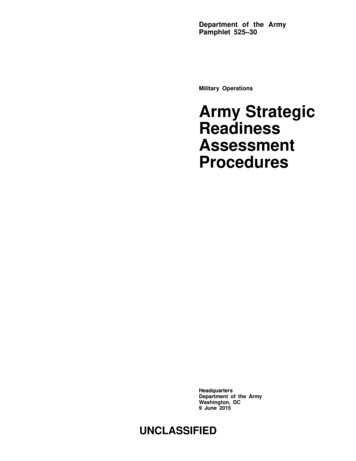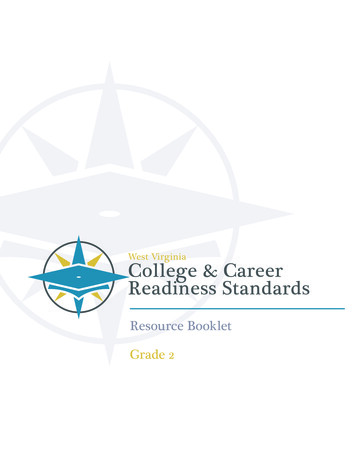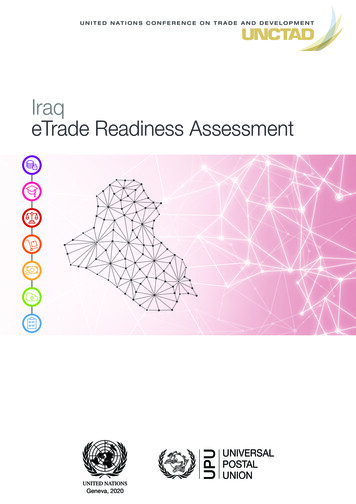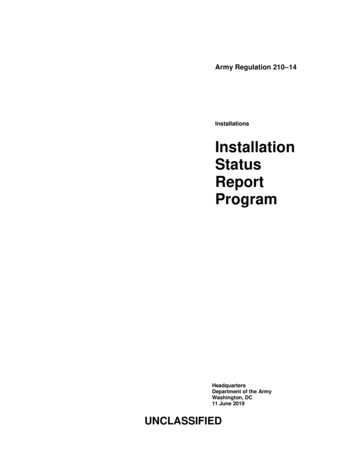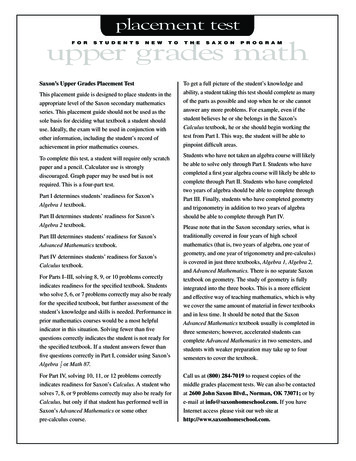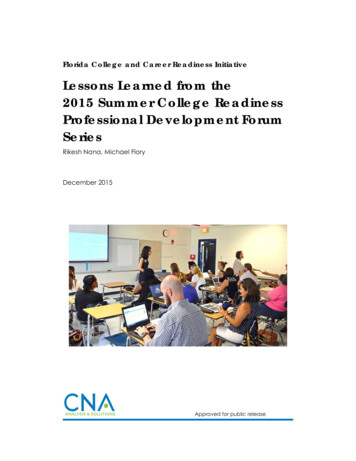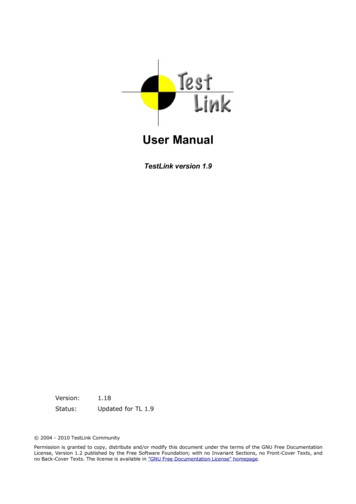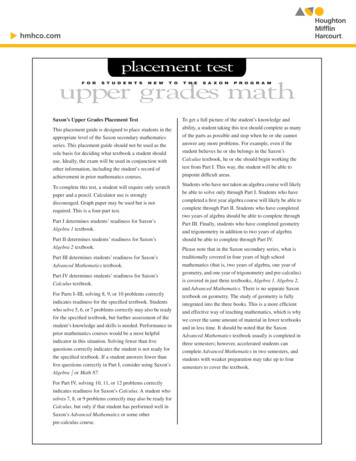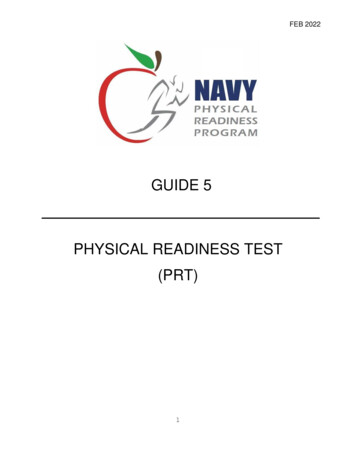
Transcription
FEB 2022GUIDE 5PHYSICAL READINESS TEST(PRT)1
FEB 2022Table of Contents(Select Ctrl Click on each topic to navigate throughout the guide)Section 1: PRT Guidelines1.2.3.4.5.PagePurpose . . PRT Components. . . .Testing Sequence . . .PRT Scoring . Overall PRT Score . .33344Section 2: Safety Concerns1.2.3.4.5.6.7.8.9.Prior to Conducting PRT . . .Conditioning and Test Site Safety .Increased Elevations Pre-physical Activity Questions .Warm-up Clothing . Hydration .Cool-Down . Injury Reporting . .556677788Section 3: PRT Modalities and Procedures1.2.3.4.5.6.Push-ups 9Forearm Plank . . 101.5 mile Run and/or Walk . 12Alternative Cardio . 12Alternate Cardio Testing Procedures . 13Grading the PRT . .18Section 4: Tables1. PRT Standards for Altitudes Less Than 5000ft . . . . 202. PRT Standards for Altitudes Greater Than 5000ft . 332
FEB 2022Section 1: PRT Guidelines1. Purpose. The PRT provides Commanding Officers (COs) with a means of assessingthe general fitness of Sailors of their command and provides a means to comply withDoDI 1308.3, DoD Physical Fitness and Body Fat Programs Procedures, policy todevelop and administer a physical fitness test that evaluates aerobic capacity, orcardiorespiratory endurance, muscular strength, and muscular endurance.2. PRT Components. The PRT components consist of a series of physical modalities thatassess cardiorespiratory fitness, muscular strength, and endurance.a. Cardiorespiratory fitness. Cardiorespiratory fitness, or aerobic capacity, isthe ability of the heart and lungs to deliver oxygen to working muscles. It is associatedwith the ability to carry out strenuous work for long durations without undue fatigue. The1.5 mile run/walk test is an indicator of cardio-respiratory endurance. The alternate cardiooptions: stationary bike, treadmill, Concept 2 rower and 500-yard/450-meter swim testsare also indicators, but participation in these events are at the CO’s discretion.b. Muscular strength and endurance. Muscular strength and endurance are theabilities to sustain muscle contractions over a period of time without undue fatigue. Thepush-ups and forearm plank events are indicators of muscular endurance. Although thereis no single endurance test that measures the endurance of all muscles; the forearm plankserves as a measure of abdominal muscle endurance while the push-up measures upperbody muscular endurance. In addition, the forearm plank, when performed properly, canhelp develop abdominal strength and endurance, which are important factors inpreventing low-back injuries.3. Testing Sequence. Testing of each required PRT modality must be completed on thesame day, with at least 5 minutes but no more than 15 minutes between each modalitytest and in the following sequence:a. Push-ups, forearm plank, then cardiorespiratory (cardio or alternate cardio).b. Due to the limited number of alternate cardio equipment available or the maximumamount of swimmers allowed in a pool, extra coordination may be required to ensureSailors do not exceed the maximum time of 15 minutes between the forearm plank andalternate-cardio modality test.c. Example of Sequencing and Command Fitness Leader Ratios. The following is anexample of a command with 200 Sailors, which requires a minimum of eight traineddesignated in writing Command Fitness Leader (CFL)/Assistant Command FitnessLeaders (ACFLs) (1-ACFL per 25 members). With eight ACFLs, four PFA sessions canbe administered simultaneously. The key elements are 1-Official (ACFL) Timekeeper, 1Official Observer (ACFL), 8-Participants (Group A), and 8-Partners (Group B). Upon3
FEB 2022completion of each PRT modality, Groups A and B are to switch from participant topartner before participating in the next modality. Four PFA sessions which consist of 64participants and partners (Groups A, B, C and D) can be successfully completed at onetime. Based on this equation, the command could complete 4 rounds of PFA sessions for200 Sailors.POSITIONOfficial TimeKeeperOfficial ObserverParticipantsPartnersRound 1Round 2Round 3Round 4200 Sailors TestedGROUP ACFLACFLSailors 8Sailors 8161616856GROUP BACFLACFLSailors 8Sailors 8161616GROUP CACFLACFLSailors 8Sailors 8161616GROUP DACFLACFLSailors 8Sailors 81616164848484. PRT Scoring. The PRT is broken down to five scoring categories, within theoutstanding, excellent and good categories there are high, medium and low levels.Satisfactory has high and medium. Probationary is the lowest category and has noadditional level. The following explains the categories:a. OUTSTANDING: Performance above or equal to top 10 percentile.b. EXCELLENT: Performance in top 25 percentile, but less than OUTSTANDING.c. GOOD: Performance better than or equal to lowest 25 percentile, but less thanEXCELLENT.d. SATISFACTORY/PROBATIONARY: Performance in bottom 25 percentile, butabove lowest 10th percentile.e. FAILURE: Performance in lowest 10 percentile.f. PARTIAL PASS: Scoring used by PRIMS to indicate that the Sailor passedthe PRT but was waived from one or more PRT event.g. BCA PASS: Scoring used by PRIMS to indicate that the Sailor passed the BCA butwas authorized a non-participation status for the PRT.5. Overall Physical Readiness Test (PRT) Score. The overall PRT score is a categorylevel performance corresponding to the average of points accumulated from the PRTmodality test results.4
FEB 2022Section 2: Safety Concerns1. Prior to Conducting PRT. CFL/ACFLs are to complete an Operational RiskManagement (ORM) analysis at least 24 hours prior to the PRT. Ensure a “changeanalysis” is conducted anytime there is a significant change in any portion of the PRT.Guidelines on conducting a successful ORM analysis may be found in OPNAVINST3500.39B, Operational Risk Management, and the COMNAVSAFECEN website.Additionally, all Sailors will eliminate all known risks to the maximum extent possible.Controls shall be put in place to reduce, to an acceptable level, any remaining risks. It isrecommended the ORM process be documented and the appropriate level of authoritywithin the chain of command be given the opportunity to make risk decisions.2. Conditioning and Test Site Safety. There is a natural risk of injury for all personnelparticipating in physical activity, even those related to improving health. The environmentand the characteristics of the participants also contribute to the overall injury risk. Sailorsmust be informed of these risks and informed of how to minimize the possibility of injury.To reduce the potential for injury, commands are responsible to ensure Sailor’s level ofphysical fitness, including acclimatization to environment, is appropriate for the physicaldemands required of Physical Training, PRT, and other physical activities.a. Acclimatization. COs have the authority to set acclimation periods, withconsultation from medical personnel (i.e., Authorized Medical Department Representative- AMDR).b. Support Personnel. The CFL/ACFLs will ensure at least one CardiopulmonaryResuscitation (CPR) certified monitor, in addition to CFL/ACFLs conducting the test, ispresent for every 25 members participating in a PRT, with a minimum of two CPRmonitors for every test. CPR monitors cannot be test participants and do not have to bemembers of the medical staff.c. Medical Emergency Assistance. A safety plan must be in place for summoningemergency assistance. At a minimum, the plan must include telephone numbers andprocedures for summoning aid, clear directions for emergency response personnel toavoid confusion and ensure prompt arrival. Include guidance for contacting basesecurity personnel to assist with rapid access of emergency personnel to test site.d. Emergency Drill. The safety plan will include an emergency drill which will beconducted prior to the PRT by the CFL with ACFLs, support personnel, and PRTmonitors. The emergency drill will assess skills and review emergency procedures.The drill will include various scenarios and will be practiced until the desired results areobtained.5
FEB 2022e. Test Site Selection and/or Certification. The CFL will select the most level 1.5mile course available. The course will be free of steep inclines and declines, surfaceirregularities, and sharp turns. Verify or measure course distance with measuring wheel(usually available from recreation services). A bike odometer may only be used ifmeasuring wheel is not available. Do not use automobile or motorcycle odometers orGlobal Positioning System (GPS) devices.f. Cardiopulmonary Resuscitation (CPR)-certified personnel locations. TheCFL/ACFLs must ensure CPR-certified personnel are in place at appropriate intervalsso the entire course is in view of monitors. The test site must be accessible toemergency vehicles and provide for telephone access for notification of emergencyservices if needed. Cellular phones, walkie-talkies, and other two-way communicationdevices are acceptable. When conducting the Swim PRT modality, at least one certifiedlifeguard must be present.g. Weather Safety Concerns. The PRT is not to be conducted under harshenvironmental conditions. Specifically, the PRT should not be conducted outdoorswhen wind chill is 20 degrees Fahrenheit or lower, or when hot weather “black flag”conditions exist (wet bulb globe temperature [WBGT]) of 90 degrees Fahrenheit orhigher.3. Increased Elevation. Increased elevation is defined as greater than or equal to 5,000feet above sea level. Elevation adjustment in the PRT scoring standards reflectsresearch based on an acclimation period of 30 days. The following guidance isprovided:a. Sailors permanently assigned or on TEMADD to locations at increased elevationwill participate in a physical readiness program, including official PFAs.b. PRTs will be conducted at nearest suitable site with lower or equal elevation.PRT procedures will not be modified due to increased elevation. Commands willinstitute all appropriate safety measures to minimize risk of injury to Sailors exercising atincreased elevation.c. See Tables 4 and 5 of this guide for the approved increased elevation PRTscoring standards.4. Pre-Physical Activity Questions (PPAQ). Sailors recovering from a recent illness orreporting a change in health or risk factors (specifically, a tightness or discomfort in thechest, arms, or neck associated with activity or exercise) are not to participate in PT.Sailors reporting a change in risk factors must be referred to medical for an evaluation andmedical clearance. The CFL/ACFLs will direct Sailors to withdraw from PT if thesesymptoms occur and contact emergency services immediately.6
FEB 2022a. Prior to the PRT or any organized group PT, CFL/ACFLs must ask the followingPPAQ:(1) Do you have a current PHA? If no, you are prohibited from participationtoday.(2) Do you have chest pain (with or without exertion), bone or joint pain, highblood pressure or high cholesterol? If yes, have you been cleared by your medicalprovider to participate in PT?(3) Do you have Sickle Cell Trait (SCT)? If yes, have you been cleared by yourmedical provider to participate in PT? If not, you are prohibited from participationtoday.(4) Have you had a change in your medical status since the last time youwere asked these questions? If yes, have you been cleared by your medicalprovider to participate in PT? If not, you are prohibited from participation today.(5) Are you ill today or know of any medical condition that may prevent youfrom participating in physical activity today? If yes, have you been cleared by yourmedical provider to participate in PT? If not, you are prohibited from participationtoday.(6) (For PRT Only): Did you complete the PARFQ (NAVPERS 6110/3)? If not,you are prohibited from participation in the PRT today.b. Sailors with any positive responses to the questions listed above must be evaluatedby an AMDR/Health Care Provider (HCP) before participating in physical activity.5. Warm-Up. The CFL/ACFLs must lead participants in a five to ten minute dynamicwarm-up exercise session or conduct the standardized PRT warm up at the start of thePRT events. See the Command Fitness /Fitness Enhancement Program (FEP) Guide 13for dynamic warm-up exercises and CFL course material for the standardized PRT warmup. The warm up session is not designed to tire Sailors.6. Clothing. The only authorized clothing for participation in an official PFA and organizedphysical training (PT) is the official Navy Physical Training Uniform (PTU).7. Hydration. Adequate fluid intake is vital to safe participation in the PRT and physicalexercise. Sailors are encouraged to drink water before and after the PRT and physicalactivity, especially in hot weather.7
FEB 20228. Cool-down. At end of the PRT, Sailors are required to participate in a cool down periodto allow the heart rate to decline gradually. Cool down should last at least ten minutes.Without cool-down, Sailors may become dizzy or light-headed.9. Injury Reporting. When Sailors are injured during a PRT or any organized PT, theCommand Safety Officer must report injuries to COMNAVSAFECEN, usingguidance contained in OPNAVINST 5100.23 (series), Navy Safety and OccupationalHealth Manual.8
FEB 2022Section 3: PRT Modalities and Procedures1. Push-Ups. The push-up modality must be performed on a flat, level surface.Blankets, mats, or other suitable padding may be used. However, Sailor must beentirely on or off the padding (i.e., Sailor’s upper body cannot be on the padding withfeet off. Sailors are required to wear shoes.a. Push-ups procedure:(1) Sailor will begin in leaning rest position on the deck so that body forms a straightline through the head, shoulders, back, buttocks, and legs. Weight is supported only withthe toes and palm of the hands. Feet shall not be in contact with the bulkhead or othervertical support surface.(2) Arms are to be straight with palms flat on the deck, directly under the shouldersor slightly wider than shoulder width.(3) Sailor shall lower entire body until arms bend to at least 90 degrees whilekeeping head, shoulders, back, buttocks, and legs aligned and parallel to the deck.9
FEB 2022(4) Sailor pushes entire body upward and returns to starting position, ensuring armsare fully extended, without locking elbows.(5) Sailor may rest only in the up position maintaining a straight line with head,shoulders, back, buttocks and legs.(6) CFL/ACFL will announce the start as well as 15-second intervals until the 2minutes have elapsed.b. Push-ups are repeated correctly as many times as possible in 2 minutes.CFL/ACFLs must monitor Sailors for correct form and count only the number of correctlyperformed push-ups. Push-ups performed incorrectly will not be counted.c. Push-ups event is ended when the Sailor:(1) Touches deck with any part of body except hands and feet.(2) Raises one hand or foot off the deck.(3) Fails to maintain proper body alignment (i.e., head, shoulders, back, buttocks,and legs in a straight line with head and heels).2. Forearm Plank. To properly execute the forearm plank modality of the PRT, there willbe no more than eight (8) participants and eight (8) partners per one (1) officialtimekeeper (CFL/ACFL) and one official observer (ACFL) (and required CPR personnel).For Recruit and Officer Training Commands, the training commands have the authority todetermine the correct monitor to recruit/candidate ratio, which must effectively ensure theintegrity of the event, given the number of recruits/candidates participating and the drillinstructor staff available.a. Forearm plank procedures:(1) The forearm plank will be performed on a flat, level surface. Blankets, mats, orother suitable padding may be used. The Sailor must be entirely on or off the padding,(i.e., upper body of the Sailor cannot be on the padding with feet off). The event willconsist of maintaining a proper forearm plank position for the maximum time allowed.(2) The Official Timekeeper (CFL/ACFL) will record time with a stopwatch to thenearest second and will give the prepatory command “EVERYBODY UP” which willprompt participants to assume the forearm plank position. Immediately afterward, theexecution command “START” will be given which prompts the official timekeeper to startthe stopwatch. Once the time has begun, the official timekeeper will also announce 1510
FEB 2022second intervals until the last participant is finished. Note: Cellphone stopwatches areprohibited.(3) Sailor will begin face down on the deck with elbows bent, forearms flat on deck,with the body in a straight line through the head, shoulders, back, buttocks and legs.(4) Elbows must be aligned directly below the shoulders at a 90-degree anglebetween the forearm and upper arm. Forearms may be parallel or angled inward, but thehands cannot be clasped together. Hands will either be in fists with the pinky side of thehand touching the deck or lying flat with palms touching the deck. Sailors may switchbetween the two hand positions, but hands and forearms cannot be lifted from the deck.(5) Feet should be placed hip-width apart. Hips must be lifted off the deck with onlythe forearms, hands and toes on the deck.(6) Knees are straight, pelvis in a neutral position and back flat. The back, buttocksand legs must be straight from head to heels and must remain so throughout the test.(7) The head and neck should be kept neutral (face looking straight down at thedeck) throughout the duration of the test so the body remains straight from the head to theheels.(8) Toes, forearms and fists or palms must remain in contact with the deck at alltimes and clasping of hands is not permitted. No part of the body of the Sailor maycontact a vertical support surface.(9) Involuntary muscle spasms (e.g., shaking, trembling, or quivering) resultingfrom maximum exertion during the exercise is anticipated and permitted as long as theproper forearm plank position is maintained.11
FEB 2022c. Forearm plank ends when:(1) Maximum time for the forearm plank has elapsed or until the last participantstops prior to the maximum time allowed.(2) Any part of the body other than hands (fists/palms) forearms, or feet touch thedeck.(3) Sailor lowers head to hands.(4) Sailor lifts hands, forearms or feet off the deck.(5) Sailor does not maintain 90 degrees at the elbow (i.e., Sailor shifts weightforward or back on forearms/toes decreasing or increasing the 90-degree bend).(6) Sailor receives more than two corrections on form. On the third correction onform, the CFL/ACFL will stop the Sailor and record the time. This will be the officialforearm plank time (score) of the Sailor.3. 1.5-mile Run and/or Walk. This cardio modality test consists of running or walking 1.5miles as quickly as possible. Any combination of running or walking is allowed tocomplete the test.a. Run/Walk Procedures:(1) Conduct on a flat and solid surface track or outdoor course.(2) Sailor will stand at start line.(3) Timer will signal start and call out time intervals until completion of test.(4) Time is recorded with stopwatch to nearest second.b. 1.5 Mile Run and/or Walk Event is ended when:(1) Sailor completes the 1.5 mile. CFL will record the time. The Sailor must remainin the area of the designated course to participate in the post PFA cool-down.(2) Sailor takes a short cut or does not complete the entire 1.5 mile course. If notcomplete (other than for injury), the cardio portion of the PRT will be scored a 59:59 inPRIMS, resulting in a failed test.4. Alternative Cardio. Although the 1.5 mile run/walk is the primary modality for testingcardiorespiratory fitness, CO/OICs have the authority to allow (or not allow) Sailors toconduct cardiorespiratory testing on approved alternate cardio options (e.g. Concept-212
FEB 2022rower, stationary bike, treadmill or swim). A detailed listing of PRP approved alternatecardio options is located in Guide 10. Testing conducted on other models is strictlyprohibited.a. CO/OICs are strongly encouraged to include in the 10-week PFA notificationwhether or not alternate cardio options are authorized.b. CFL/ACFLs must verify the safety/start/stop and testing procedures work accuratelyon each machine prior to the test day.c. CFL/ACFLs must ask the Sailor if they have practiced on that alternate cardiospecific machine or model. If Sailor has not practiced prior to day of test, the CFL/ACFLwill not administer the alternate cardio and reschedule the Sailor to participate in the entirePRT another day.5. Alternate Cardio Testing Procedures. CFL/ACFLs must have authorization from theCO/OIC for the current PFA cycle for alternate cardio options.a. 2000-meter Row. Sailors who intend to test on the rower for the PRT are requiredto train and familiarize themselves on the approved Concept-2 rower. The followguidance is provided to assist CFL/ACFLs in successfully conducting the PRT for the2000-meter row on approved Concept-2 rowers (Models D and E only with PerformanceMonitor 3, 4 or 5):(1) Instruct Sailor to set damper setting on the flywheel of their choosing. Sailor willnot be able to adjust the damper setting during the test.(2) Instruct Sailor to sit on rower machine then adjust thefootplate placements and secure feet using adjustable straps.The foot straps should be secured at the widest portion of thefoot to permit freedom of movement of the heel during rowing.(3) Sailor should grasp the handle with both hands andplaced along the outer edge of the handle. Once the Sailorbegins pulling on the handle, they should remain in constant andcontinuous motion (to prevent inadvertent monitor cut-off, whichwould result in a test graded as a failure) until the 2000-metertest is complete.(4) CFL/ACFLs will program the rowing machine performance monitor with thefollowing items:(a) From the main menu of the performance monitor, press the “SelectWorkout” button.13
FEB 2022(b) Press the "Standard List" button and then select “2000 m”.(c) Press “Change Display” until the top line shows “2000m 0 s/m”, the thirdline will show the overall elapsed time (00:00) and the bottom line will show the projectedfinish time.(5) The event begins when the CFL/ACFL givesthe command “START”. Time starts automatically onthe rowing performance monitor display when the Sailorstarts rowing. The rowing distance display counts downfrom “2000 m” to “0 m”.(6) Once Sailor reaches “0 m”, the CFL/ACFLannounces and records elapsed time from performancemonitor rounding the time to the nearest whole second(0.4 and lower, round down; 0.5 and higher, round up).(7) The Sailor begins the test by pressing withtheir legs and moving entire body back away from theperformance monitor.(8) The rower event ends when the Sailor:(a) Completes 2000-meters.(b) Stops rowing for a period long enough that the monitor turns off.(9) If Sailor does not complete the rower portion of the PRT, other than for injury,the time will be recorded as 59:59 and scored as “FAILED”. In the event the Sailor wouldlike to participate in the Bad Day PRT, Sailor must be cleared by medical prior to COapproval.14
FEB 2022b. Treadmill. The treadmill must have a motor-driven running surface belt with anemergency stop button, adjustable speed displayed in miles per hour, inclinationadjustment, and odometer that accurately measures distance traveled in miles.(1) The follow procedures are provided to successfully conduct the PRT on anapproved treadmill:(a) Sailor will stand on the belt with treadmill inclination set at 1.0percent. Neither the treadmill belt nor stopwatch is running.(b) CFL/ACFL will signal start and Sailor will start the treadmill at desired speed.Sailor is required to step onto the belt as soon as it starts moving, i.e., not wait until thebelt has reached its programmed speed. As soon as the belt moves, the CFL or ACFLwill start the official time using a stopwatch.(c) CFL/ACFL will announce the start and call time within two minute intervalsuntil the Sailor has traveled 1.5 miles.(d) Treadmill speed may be adjusted to Sailor’s comfort anytime during test.(e) Sailor may momentarily touch the treadmill’s safety bar withfingertips or open palm for safety to recover balance. Sailor may not, however, grab orhold onto the bar for any reason other than to recover balance.(f) Sailor is allowed to briefly pause the treadmill to retie a shoelace. Nodistance shall be counted towards the Sailor’s score during the pause. The stopwatch,however, will continue to run.(g) Time is recorded with a stopwatch to nearest second. Although mosttreadmills are equipped with an accurate time display; only the time recorded bystopwatch shall be used for official scoring. This is done to account for the time during apause.(2) Treadmill event is ended when the Sailor:(a) Completes 1.5 miles.(b) Stops running or walking other than to retie shoelace or to remove a foreignobject from their shoe (for safety purposes). If this should occur, the Sailor must pausethe machine.(c) Supports body weight by holding onto or leaning against the treadmillsupport bar other than to momentarily regain balance.15
FEB 2022(d) Changes treadmill inclination from 1.0.c. 500-yard or 450-meter Swim. The swim event may be conducted if facilities arereasonably available. The swim event consists of swimming 500 yards or 450 meters infastest time possible. Any swim stroke and turn may be used and will only be conductedin a standard 25 or 50 yard/meter swimming pool.(1) The follow procedures are provided to successfully conduct the PRT Swim:(a) Swimmer will begin test in water. No diving starts.(b) CFL/ACFL will announce the start as well as number of pool lengthsand associated times until Sailor has completed either 500 yards or 450 meters.(c) Time will be recorded with a stopwatch to nearest second.(d) Swimmer may push off from sides with hands and feet after each poollength.(e) Resting is permitted by holding side of pool, standing, or treading water.(f) Sailors may use goggles, facemasks, swim caps, and/or ear plugs. Fins,snorkels, flotation, wet suit, and propulsion devices are strictly prohibited.(2) Swim event is ended when Sailor:(a) Completes prescribed distance.(b) Receives or requires physical assistance from CFL/ACFL, lifeguard, oranother person.d. Stationary Bike Testing (Non-Life Fitness Inc./Integrity Series Upright Bike). Thefollowing procedures are provided to successfully conduct the PRT on the non-LifeFitness, Inc. stationary bike:(1) Ensure machine data is cleared prior to programming for the test.(2) Instruct Sailor to sit on the bike.(3) Program the following items in the order required by specific machine:- Manual program.- Resistance level of Sailor’s choice.16
FEB 2022- Set the test duration time to 14 minutes (although the actual test duration is 12minutes this accounts for machines that utilize automatic cool-down).(4) Allow the Sailor to vary resistance/load as appropriate.(5) At the 12 minute mark, read, announce and record caloric output fromstationary bike console. Test is complete when exactly 12 minutes is reached.(6) Allow the Sailor to cool-down as needed. The additional calories burnedduring the cool-down period shall not be used for scoring.(7) A caloric output of “20” will be entered into PRIMS if any of the following occurduring the test:- Stops to rest.- Stops the machine.- Stands up.- Removes hands from handlebars (other than shortly required for comfort, e.g.,to adjust the resistance, wipe off sweat, etc.).e. Stationary Bike Testing (Life Fitness Inc./Integrity Series Upright Bike). Thefollowing procedures are provided to successfully conduct the PRT on the Life Fitness,Inc. stationary bike:(1) Ensure machine data is cleared prior to programming for the test.(2) Instruct Sailor to sit on the bike.17
FEB 2022(3) Program the following items in the order required by specific machine:- Using Item 4, select the first button on the left with this ( -- )symbol. This is your MANUAL workout key.- Select Item 7 for TIME, use the up/down arrow to select timeenter 14 minutes (although the actual test duration is 12 minutes this accounts forautomatic cool-down). Indicator (8) will illuminate for time.- Select Item 7 to Increase or Decrease resistance LEVEL, use theup/down arrow to select resistance level.- Select Item 7 to adjust Sailor’s WEIGHT, use the up/downarrow to select weight for Sailor. Indicator (8) will illuminate for weight.- Select Item 2 GO to start the PRT test.(4) Allow the Sailor to vary resistance/load as appropriate.(5) At the 12 minute mark, read, announce and record caloric output fromstationary bike console (Item 1). Test is complete when exactly 12 minutes is reached.(6) Allow the Sailor to cool-down as needed. The additional calories burnedduring the cool-down period shall not be used for scoring.(7) A caloric output of “20” will be entered into PRIMS if any of the following occurduring the test:- Stops to rest.- Stops the machine.- Stands up.- Removes hands from handlebars (other than shortly required for comfort, e.g.,to adjust the resistance, wipe off sweat, etc.).6. Grading the PRT. The PRT is passed when a Sailor achieves a score of probationaryor higher performance standard on the PRT modalities (Push-ups, forearm plank and onecardio or alternate cardio event. Failure to so, will result in a PRT failure. In the event aSailor is medically waived from any portion of the PRT, grading will be determined fromthe modalities which the Sailor participated in.18
FEB 2022Section 4-1PRT Standards for Altitudes Less Than 5000 Ft19
FEB 202
Cardiorespiratory fitness, or aerobic capacity, is the ability of the heart and lungs to deliver oxygen to working muscles. It is associated with the ability to carry out strenuous work for long durations without undue fatigue. The 1.5 mile run/walk test is an indicator of cardio-respiratory endurance.
